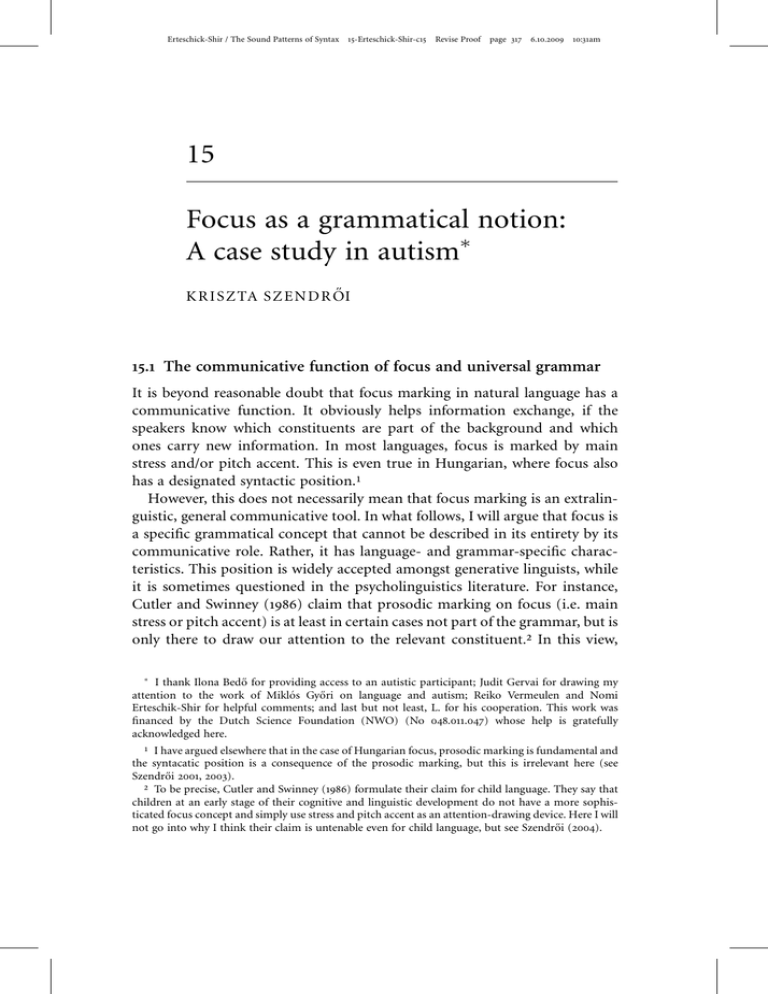Document 12581037
advertisement

Erteschick-Shir / The Sound Patterns of Syntax 15-Erteschick-Shir-c15 Revise Proof page 317 6.10.2009 10:31am 15 Focus as a grammatical notion: A case study in autism } K R I S Z TA S Z E N D R OI 15.1 The communicative function of focus and universal grammar It is beyond reasonable doubt that focus marking in natural language has a communicative function. It obviously helps information exchange, if the speakers know which constituents are part of the background and which ones carry new information. In most languages, focus is marked by main stress and/or pitch accent. This is even true in Hungarian, where focus also has a designated syntactic position.1 However, this does not necessarily mean that focus marking is an extralinguistic, general communicative tool. In what follows, I will argue that focus is a speciWc grammatical concept that cannot be described in its entirety by its communicative role. Rather, it has language- and grammar-speciWc characteristics. This position is widely accepted amongst generative linguists, while it is sometimes questioned in the psycholinguistics literature. For instance, Cutler and Swinney (1986) claim that prosodic marking on focus (i.e. main stress or pitch accent) is at least in certain cases not part of the grammar, but is only there to draw our attention to the relevant constituent.2 In this view, I thank Ilona Bed} o for providing access to an autistic participant; Judit Gervai for drawing my attention to the work of Miklós Gy} ori on language and autism; Reiko Vermeulen and Nomi Erteschik-Shir for helpful comments; and last but not least, L. for his cooperation. This work was Wnanced by the Dutch Science Foundation (NWO) (No 048.011.047) whose help is gratefully acknowledged here. 1 I have argued elsewhere that in the case of Hungarian focus, prosodic marking is fundamental and the syntacatic position is a consequence of the prosodic marking, but this is irrelevant here (see Szendr} oi 2001, 2003). 2 To be precise, Cutler and Swinney (1986) formulate their claim for child language. They say that children at an early stage of their cognitive and linguistic development do not have a more sophisticated focus concept and simply use stress and pitch accent as an attention-drawing device. Here I will not go into why I think their claim is untenable even for child language, but see Szendr} oi (2004). Erteschick-Shir / The Sound Patterns of Syntax 15-Erteschick-Shir-c15 Revise Proof 318 page 318 6.10.2009 10:31am Kriszta Szendr} oi focus marking is similar to saying something louder so that the hearer has a better chance of understanding what we say. When the speaker applies focus marking on a constituent, he simply wants to draw the hearer’s attention to the focal constituent. The hearer, in turn, notices the prosodically marked constituent and concludes that the speaker used this marking to draw his/her attention to this constituent. In contrast, the generative position is that the concept of focus and focus marking is part of universal grammar (see e.g. Chomsky 1971; Reinhart 2006). In other words, every normally developing child knows what focus is and that languages mark focus prosodically (by main stress or pitch accent) due to their genetic endowment. Although the literature abounds with theoretical support for the generative position, there is relatively scarce experimental evidence available. My aim here is to add to this body of work, hoping that such an endeavor helps interaction between theoretical and experimental linguistics and thus, in the long run, contributes to the making of a conceptually sound and psychologically realistic grammar. An important diVerence between the two approaches to focus marking described above is that while in the generative approach production and comprehension of focus is the result of an automated, language-speciWc process, in the rival theory a pragmatic (or more general) deductive step is necessary. Namely, in order to be able to identify the communicative import of the stressed constituent, the hearer has to assume that it was the speaker’s intention to signal this. In other words, this approach to focus assumes that communication is intentional in nature. Intentional communication means that the meaning of each communicative unit (e.g. an utterance) involves the eVect that the speaker has on his/her audience due to the fact that the audience is aware that the speaker is not only delivering a message, but also trying to have an eVect on his/her audience by his/her utterance (see Grice 1957; Sperber and Wilson 1995, etc.) Take an example: if a guest says to his host: It’s cold in here, his intention is not only to make the host aware of this fact, but also, by uttering this sentence, he intends to have an eVect; for instance, he wants to make the host turn on the heating. The host, in parallel, will not only acknowledge that according to her guest the temperature in the room is low, but also take into account that the guest had some aim in mind when uttering this statement, and so she will try to deduce this aim. In the speciWc case of focus, the speaker’s intention is to get the hearer to interpret the focal constituent as new, relevant information, while the hearer, upon hearing the focal utterance, has to deduce this intention of the speaker. Erteschick-Shir / The Sound Patterns of Syntax 15-Erteschick-Shir-c15 Revise Proof page 319 6.10.2009 10:31am Focus as a grammatical notion 319 This deductive step is not necessary if one adopts the generative standpoint. Here, the constituent bearing main stress will be automatically interpreted as focal, i.e. as new and relevant information, because this is what the focus-marking rule in the grammar prescribes. It is not necessary for the hearer to deduce the speaker’s intention to mark the constituent as focus. Actually, it is irrelevant whether the speaker had any such intention when uttering a focal utterance.3 But how could we Wnd evidence that would help us choose between these two approaches to focus marking? Introspection, the common tool of theoretical linguistics, is of little help in this matter. If we were to ask the speaker whether he had any intention to get the hearer to interpret the focal constituent as new information, he/she would of course claim that it was his/her intention to do so. The hearer, on the other hand, is of course capable of Wnding out that this was the speaker’s intention. But this does not necessarily mean that speakers identify foci as a result of this thought process. However, the point where the two focus theories diverge is precisely the method they assume for the identiWcation of a focal constituent: by using an automated grammatical rule, or by deducing the other’s intention. If our aim is to investigate whether a speciWc focus-marking rule is truly available in the grammar of human languages, then we have to create an experimental setting where the deductive process is unavailable for some reason. If in such a situation, the speaker’s ability to identify the focus did not diminish, then we could conclude that a language-speciWc tool is available to him/her; he/she does not have to rely on the communicative deduction process to identify the focus.4 3 An important contribution on this issue is Erteschik-Shir’s (1997) position. She deWnes focus in the pragmatic sense, as in (i). But she also states that ‘For any sentence several focus assignments will generally be possible, one of which is realised in discourse. A sentence, in discourse, has only one main focus, which is assigned to a syntactic constituent. The constituent may be an NP, VP or the whole S’ (Erteschik-Shir 1997: 11; my italics). The crucial point is that although she states that focus has a particular pragmatic function (as in (i)), it is grammatically encoded by assigning f-marking to a syntactic constituent. (i) The Focus of a sentence S ¼ the (intension of) a constituent c of S which the speaker intends to direct the attention of his/her hearer(s) to, by uttering S (Erteschik-Shir 1997: 11; originally from Erteschik-Shir 1973). 4 Note that the reverse is not true. In an experimental setting where the grammar-speciWc focusmarking rule is blocked for some reason, we cannot conclude anything from the speaker’s undiminished ability to identify the focus correctly. This is because the generative theory does not claim that the availability of the grammar-speciWc focus-marking rule precludes the ability to carry out a communicative deduction process. It only claims that the grammar-speciWc rule is available, presumably alongside general, communicative deductive mechanisms. In other words, if in this speciWc situation, the speaker relies on his/her deductive mechanisms to determine the focus, it does not follow that he/she would do the same were the grammar-speciWc rule available to him/her. Erteschick-Shir / The Sound Patterns of Syntax 15-Erteschick-Shir-c15 Revise Proof page 320 6.10.2009 10:31am Kriszta Szendr} oi 320 At this point, the psycholinguistic method appears to be useful. If we could identify a population where we have reason to believe that the communicative deductive steps that are necessary to identify the focus are not available to the speaker, we could investigate whether focus marking and focus identiWcation are impaired in this population. In section 15.3, I will argue that people with autism constitute an adequate population to carry out this investigation. But Wrst we need to introduce some basic notions that organize discourse. 15.2 Focus and background Focus has an important role in the organization of discourse. When we speak, our sentences often contain constituents that have already been referred to, and also others that are new at that particular point of the discourse. Any answer to a question is relevant, new information. We thus take the focus of an utterance to be the constituent that answers an implicit or explicit question in a discourse. Accordingly, the most common focus test is the so-called wh-test. As shown in (1), the focus of the utterance is ‘Snow white’, as this is the constituent that provides an answer to the preceding question. (1) A: Who ate the apple? B: Snow white ate the apple. In Hungarian, as opposed to English, focus has a designated syntactic position: it immediately precedes the verb, while the verbal particle is postverbal, as in (2). In addition, just as in other languages, the focal constituent is also prosodically marked: it gets main stress (indicated by small caps in the examples) and constituents that follow it undergo stress reduction (Kalman and Nadasdy 1994). The constituent that follows the moved focus is called the background: (2) focus background HfehØrke ette meg az almat. snow white ate prt the apple-acc ‘Snow white ate the apple.’ We could say that the most extreme form of deaccenting is when the deaccented constituent is erased completely, as in (3) (see Williams 1997). Erteschick-Shir / The Sound Patterns of Syntax 15-Erteschick-Shir-c15 Revise Proof page 321 6.10.2009 10:31am Focus as a grammatical notion (3) A: 321 Ki ette meg az almat? ‘Who ate the apple?’ B: HfehØrke. Snow white. Of course, in everyday life we do not only converse using question-answer pairs. But there are other conversational situations where it is possible to reliably identify the focus of the utterance. For instance, if a speaker corrects the other speaker, then the relevant constituent is the focus of his/ her utterance: (4) A: A herceg megkóstolta az almat. ‘The prince tasted the apple.’ B: Nem. HfehØrke kóstolta meg az almat. no Snow.white tasted prt the apple-acc ‘No. Snow white tasted the apple.’ Note that in such situations it is inappropriate to omit the postfocal constituent: (5) A: A herceg megkóstolta az almat. ‘The prince tasted the apple.’ B: Nem. #HfehØrke. no Snow.white ‘No. Snow white.’ To be more precise, omission of the postfocal constituent is only appropriate if the Wrst speaker already used a marked focus on the agent, in other words, if the omitted constituent had been marked as background by the Wrst speaker:5 (6) A: A herceg kóstolta meg az almat. the Prince tasted prt the apple-acc ‘The prince tasted the apple.’ B: Nem. HfehØrke. no Snow.white ‘No. Snow white.’ 5 Note that the same is true in English (cf. (i) and (ii)). (i) A: The Prince tasted the apple. B: No. Snow white #(did). (ii) A: The Prince tasted the apple. B: No. Snow white (did). Erteschick-Shir / The Sound Patterns of Syntax 15-Erteschick-Shir-c15 Revise Proof 322 page 322 6.10.2009 10:31am Kriszta Szendr} oi So far, we have demonstrated that in order to use focus and background marking properly in discourse, the speaker has to be aware of at least the following grammatical rules: (i) focus bears the main stress of the utterance, and in Hungarian, it immediately precedes the verb, (ii) the backround is destressed, (iii) the background can be omitted if it is the same as the background of the previous utterance. 15.3 Autism Autism is a developmental disorder with genetic roots. Its most important symptoms are that a person with autism has an impairment in his/her ability (i) to create and maintain social relationships, (ii) to take part in interpersonal communication (both verbal and non-verbal), and (iii) to organize his/ her interests and behavior in a Xexible manner (WHO 1990). Autism is often accompanied by severe mental retardation, in which case linguistic abilities are often severely deWcient. Autism that is not accompanied by mental retardation is called Asperger’s syndrome, or high-functioning autism; some people with this form of autism may actually have higher than average IQs. The typical symptoms of high-functioning autism are (i) in the realm of social interactions—interactions are too formal, rigid, and often restricted to a stereotypical Weld of interest; (ii) in the realm of communication—formally sound, but pedantic speech, poor articulation, unusual tone, intonation and speed of speech, comprehension outperforms production; (iii) concerning stereotypical, repetitive behavior—intense interest in a narrow, stereotypical area (e.g. constant studying of the TV program) (Gy} ori 2003: 68). According to Gy} ori (2003: 79), the hardest problem researchers investigating autism face is the heterogeneity of the syndrome in a range of diVerent ways. A wide range of variation occurs in the causes of the onset of autism, in its neurobiological background, in the nature and extent of the cognitive deWcit, in the make-up of the set of symptoms, and in the occurring developmental patterns. In spite of this, we know since seminal work by BaronCohen et al. (1985) that people with autism lack the fundamental cognitive ability of (naive) theory of mind, or mentalization.6 It is this ability that allows us to ascribe mental states (belief, desire, emotional states, intentions) to diVerent agents and to assume that such mental states are the root cause of the behavior of these agents. In other words, in everyday life it is our theory 6 It is an open question whether people with autism have impairments concerning other cognitive functions, besides the impairment of their theory of mind. I will not go into this here, but see for instance Gy} ori (2003: 115–25) for an overview of this issue. Erteschick-Shir / The Sound Patterns of Syntax 15-Erteschick-Shir-c15 Revise Proof page 323 6.10.2009 10:31am Focus as a grammatical notion 323 of mind that allows us to interpret, explain, and to some extent foresee complex human behavior. There is a well-established link between theory of mind and ability for verbal and non-verbal communication (see e.g. Sperber and Wilson 2001 and references there). Due to the intentional nature of interpersonal communication described above, speakers must be aware of the communicative intentions of their conversational partner. Evidently, they need to be able to regard them as creatures capable of mental processes, i.e. they must be able to assign mental states (such as belief) and intentions (such as will) to the other speakers. Numerous experimental studies support the presence of a theory of mind deWcit in people with autism (see e.g. Baron-Cohen et al. 1985; Perner et al. 1989; Happé 1993; Baron-Cohen 1995). As a result, these people form a population that provide an excellent opportunity for the investigation of issues regarding language use and pragmatics, and thus, consequently also the issue of focus marking.7 More speciWcally, if focus were not marked by grammar-speciWc tools, we would expect that people with autism would Wnd focus marking and focus identiWcation problematic. This is so, because the general deductive process that would be necessary to determine the focus, which was described in the previous section, requires a theory of mind on the part of the speaker, which is not available for people with autism. Therefore, if we Wnd that at least in certain conversational situations, focus marking and focus identiWcation are not problematic for an autistic person, then we can conclude that focus marking follows grammar-speciWc rules.8 This was the outcome of the case study described in the following section. 15.4 A case study 15.4.1 The experimental participant L. was diagnosed with autism at a young age. At the time of the experiment, he was 13 years old. He had a normal (100) non-verbal IQ. According to the psychologist who treats him, he is a high-functioning autistic patient, as he 7 This is a simpliWcation. Gy} ori (2003) showed that, although most people with autism have a severe theory of mind deWcit, certain compensational strategies may signiWcantly ameliorate their experimental results. Moreover, based on some of his experimental Wndings, Gy} ori (2003: 12) concludes that certain autistic people actually have complex mentalizational abilities. 8 As is standard in psycholinguistic research, this line of thought assumes that a neurologically impaired population does not possess (or hardly possesses) any abilities that are not available to the normal population. This is not an innocent assumption, but a necessary one, as otherwise we would not be able to make any predictions about the normal population based on experimental Wndings from a neurologically impaired population. Erteschick-Shir / The Sound Patterns of Syntax 15-Erteschick-Shir-c15 Revise Proof 324 page 324 6.10.2009 10:31am Kriszta Szendr} oi manages well in many complex situations in life (e.g. gets around town alone). L.’s behavior shows many autistic symptoms: poor eye contact; stilted, too formal conduct; unexpected changes of subject while conversing; surprisingly detailed interest in particular areas (such as the public transportation system of Budapest). His speech is Xuent, but ‘dry’. His intonation is Xat and he is liable to understand things literally. His linguistic abilities are without doubt very good: his sentences are often complex, his vocabulary is large. He commits few grammatical mistakes in his spontaneous speech. Some examples of these are an occasional topic drop (which is not allowed in Hungarian), or the use of indicative mood instead of the conditional in irrealis situations.9 Observing L.’s spontaneous behavior reveals a deWcit in his functional mentalizational abilities. Due to lack of time, I could not acquire experimental proof of this. It can be regarded as anecdotal evidence for instance that while it posed no problems for L. to understand why Wre extinguishers do not contain water (namely, because water cannot be used to put out Wres involving electricity and at the moment of manufacturing it is impossible to know in advance for what kind of Wre the extinguisher would be used), he was completely incapable of understanding that the fact that in Hungarian ‘folklore’ chimney sweepers bring luck is a superstitious belief (i.e. people believe it even though it is not really true).10 9 It is interesting to note that the observed ungrammatical verbal mood inXection occurred in an irrealis situation, as in (i). This sentence was uttered after I showed a picture to L. where a lost dog was delivered to his owner by a policeman, and the dog, happy to see him again, licks his owner. (i) L. (laughing) – Mi lenne, ha a kutyus a rend} ort nyalna meg, és akkor what be-cond if the doggy the policeman-acc lick-cond prt and then [a rend} or] megijed(-ne). the policeman frightens(-cond) ‘Imagine if the doggy licked the policeman! Then he would be frightened!’ It is possible that this is not a coincidence but reXects L.’s diYculties in conceptualizing the situation. This would not be surprising, as it is likely that conceptualizing a situation like this would require theory of mind, as one must be able to assume that the policeman is capable of the mental state of being frighetened. The issue whether lack of irrealis morphology reXects a conceptual diYculty would require further research. 10 It was also interesting how L. told a story how he once switched oV his mobile phone so that people could not disturb him, as he wanted to go see the terminus of the underground line after school. He got delayed and by the time he got home, his parents were really worried about him. In his narrative, his mother was worried that he had had an accident, but L. did not understand this, because he had not had an accident. This also shows that L. has diYculties assuming that another person, in this case his mother, could believe things to be true that are in fact not true. It is widely accepted that an ability to ascribe false belief to an agent requires mentalization. Erteschick-Shir / The Sound Patterns of Syntax 15-Erteschick-Shir-c15 Revise Proof page 325 6.10.2009 10:31am Focus as a grammatical notion 325 15.4.2 The experimental task In the course of the experiment L. carried out a bi-modal elicited production task, following Baltaxe (1984). The bi-modal stimulus involved the simultaneous presentation of a picture and an utterance uttered by the experimenter about the picture. The task of the participant was to determine whether the experimenter can see well what is on the picture, and if not, correct her. I made sure that it was plausible that the experimenter might make mistakes: the pictures were placed right in front of L. and relatively far away from the experimenter, so it was possible for her to claim that she did not see the picture properly. As a result, L. understood the experimental task to be a picture recognition task. This was a typical stimulus: Figure 15.1 Picture for test item The girl is stroking a cat. (7) Experimenter (E): –A lany simogat egy cicat. the girl strokes a cat-acc ‘The girl is stroking a cat.’ Expected answer: –Nem. A lany egy kuty at simogat. no the girl a dog-acc strokes ‘No. The girl is stroking a dog.’ Both Baltaxe’s original aim and my aim in this experiment was to use the stimuli to create a situation where the participant has to use focus. Erteschick-Shir / The Sound Patterns of Syntax 15-Erteschick-Shir-c15 Revise Proof page 326 6.10.2009 10:31am 326 Kriszta Szendr} oi Table 15.1 Number of correct responses Test items (expected answer: NO + correction of experimenter) Controls (expected answer: YES) 84% (63/75) 100% (15/15) The theoretical basis for this method is the observation, described above in (3), that correction of an utterance involves focusing the corrected constituent. 15.4.3 The conduct of the experiment The picture recognition game was introduced after a lengthy spontaneous conversation with L. The experiment lasted about one hour, including short interruptions of spontaneous discourse. During the experiment, L. received 90 test items (i.e. stimulus pairs), 17 percent (15/90) of which required no correction, while 83 percent (75/90) required correction of the statement uttered by the experimenter. As L. believed that the experimental task was picture recognition, I did not think it necessary to introduce extra Wllers. 15.4.4 Results and discussion L. did not make mistakes when there was no discrepancy between the picture and the utterance. In 84 percent of the cases where a discrepancy occurred, he correctly identiWed it. (see Table 15.1). In the remaining 16 percent of cases, L. either could not conclude what exactly was in the picture, or he understood things too literally and was unable to use inference to deduce the nature of the discrepancy. The breakdown of incorrect responses is given in Table 15.2, while (8) provides an illustrative example. (8) a. E: - . . . és sötétszı́nű pólóban van. and dark-coloured T_shirt-loc is ‘. . . and he is wearing a dark T-shirt.’ Table 15.2 The breakdown of incorrect responses Incorrect responses: a. L.: ‘I can’t see it properly.’ b. L. failed to notice the discrepancy Total: 11% (8/75) 5% (4/75) 16% (12/75) Erteschick-Shir / The Sound Patterns of Syntax 15-Erteschick-Shir-c15 Revise Proof page 327 6.10.2009 10:31am Focus as a grammatical notion L: 327 -Azt nem lehet tudni, mert itt that-acc not possible know-inf because here fehérnek tűnik a fekete- fehérben. white-dat appears the black- white-loc ‘It’s impossible to tell, because it seems white in the black and white [picture].’ E: -Akkor valószı́nű inkabb vilagos szı́nű, ugye? Mert then likely more light coloured tag because a nadragja, az sötét. the trousers-poss that dark ‘Then it is more likely to be light coloured, isn’t it? Because his trousers, those are dark.’ L: b. -Igen, azt feketében jelzi. yes that-acc black-loc signals ‘Yes. Those are signaled by black.’ E: - . . . és a gyerek akinek megnézi a fogat az and the child whose sees the tooth-acc that sz} oke hajú. blond haired ‘. . . and the child whose teeth he is looking at is blond.’ L. -Sarga szı́nű. yellow coloured ‘It’s yellow.’ E: -Sarga szı́nű. Nem lehet megallapı́tani a yellow coloured not possible state-inf theloc képr} ol, hogy . . . picture- that ‘It’s yellow. It is not possible to tell from the picture whether. . .’ L.: -Nem lehet. not possible ‘It’s not possible.’ It is not surprising that L. experienced diYculties both in picture recognition and in interpretation, as certain picture recognition diYculties and a too literal interpretation of pictures are both characteristic symptoms of autism (see for instance Gy} ori 2003). The breakdown of correct responses is given in Table 15.3. Here we get a better picture of the nature of the utterances L. intended as corrections. Erteschick-Shir / The Sound Patterns of Syntax 15-Erteschick-Shir-c15 Revise Proof page 328 6.10.2009 10:31am Kriszta Szendr} oi 328 Table 15.3 The breakdown of correct responses for test items Correct responses: a. Pragmatically appropriate, elliptic answer with correct intonation b. Pragmatically appropriate, syntactically correct full-sentence answer with correct intonation c. Pragmatically inappropriate, elliptic answer with correct intonation d. Pragmatically appropriate, elliptic answer with incorrect intonation Total: 53% (40/75) 19% (14/75) 3% (2/75) 9% (7/75) 84% (63/75) In more than half of the cases, L. gave an elliptic answer with focal stress that was appropriate in the discourse. Examples are given in (9). In (9a), nominative case indicates that the elided part is something like That’s a . . . rather than the experimenter’s utterance. Ellipsis is licensed here. In (9b) the presence of the copular verb in the experimenter’s utterance licenses the ellipsis. In (9c), which follows on from previous discourse given in (10a) below, the experimenter’s question provides the necessary licensing for the ellipsis. In all of these cases, the focal constituent bears focal stress, so these responses can be regarded as correct responses. (9) a. E: -Itt egy televiziót latunk ahol a bemondón} o here a tv.set-acc see-we where the presenter-woman épp a hı́reket mondja. just the news-acc says ‘Here we can see a telly, where the presenter[woman] is reading out the news.’ L: b. -Bemondób acsi! presenter-man ‘Presenter-man’ E: -A kislanynak kék nadragja van. the little.girl-gen blue trousers-poss is ‘The little girl has blue trousers.’ L: -Piros. red ‘red [ones]’ c. E: -Igen? Mit tapaszt ra? yes what-acc glues prt ‘Yes? What does he glue on [the wall]?’ Erteschick-Shir / The Sound Patterns of Syntax 15-Erteschick-Shir-c15 Revise Proof page 329 6.10.2009 10:31am Focus as a grammatical notion L: 329 -A TØgl at. the brick-acc ‘The brick.’ In a further 13 percent of the cases, L.’s response was a full sentence with focus on the relevant constituent, both syntactically and prosodically. In (10a) he utters an all-focus utterance, correctly stressing every constituent. In (10b) there is correct focus marking on both contrasted elements (teeth; dentist) and in (10c) the focus marking appears on the contrasted verbs (to begin to kick; to push out). (10) a. E: -Ezen a kapen egy munk ast latunk this-loc the picture-loc a worker-acc see-we amint éppen festi a falat. as just paints the wall-acc ‘In this picture, we see a worker as he is painting the wall.’ L: b. - . . .R atapasztja a Falra a H azØptØsnØl . . . prt-glues the wall-loc the house-building-loc ‘He glues [them] onto the wall while building a house.’ E: -Ezen a képen egy orvost latunk, aki this-loc the picture-loc a doctor-acc see-we who fülész és viszgalja a gyereknek a fülét. ear.specialist and examines the child-gen the ear-acc ‘In this picture we see a doctor. He is an ear specialist and he is examining the child’s ear.’ L: -Nem, nem, nem, nem, nem. ‘No, no, no, no, no, no.’ E: -Hanem? ‘Rather?’ L: -Hanem a Fog at nézi meg egy Fogorvos. rather the tooth-acc looks prt a dentist ‘Rather, his teeth are examined by a dentist.’ c. E: -Ezen a képen egy focista van és éppen this-loc the picture-loc a footballer is and just all a kapuban és kivédi a labdat. stands the goal-loc prt-defends the ball-acc ‘In this picture, we see a footballer as he is standing in goal and pushes the ball out.’ Erteschick-Shir / The Sound Patterns of Syntax 15-Erteschick-Shir-c15 Revise Proof page 330 6.10.2009 10:31am Kriszta Szendr} oi 330 L: -Rœgni kezdi. kick-inf begins ‘He begins to kick [it].’ Note, however, that there were several cases, where L.’s utterance was pragmatically marginal, even though focus marking was correct. These were elliptic utterances, where the use of ellipsis was not appropriate. (11) a. (In the picture there is a puppy with two plates. One has milk, the other water. The doggy splashes the milk around. He does not touch the water.) E: -Na hat itt viszont ez a kiskutya itt prt prt here in.contrast this the doggy here rosszalkodik, mert ahelyett, hogy meginna a behaves.bad because instead that drink-cond the tejecskét, ahelyett kiönti. milk-dim-acc instead prt-pours ‘Here the doggy is misbehaving: instead of drinking the milk he is splashing around with it.’ L: -Az Innivalójat. the drink-poss-acc ‘His drink.’ E: -Mit? ‘What?’ L: -A vizet. the water-acc ‘The water.’ E: -A vizet önti ki. the water-acc pours prt ‘He is splashing around with the water.’ b. E: -Na ezen a képen viszont nagyon rendesen prt this-loc the picture-loc in.contrast very nicely viselkedik és megissza a vizet. behaves and prt-drinks the water-acc ‘Now, in this picture [the doggy] behaves himself and drinks the water.’ L: -A Tejet. the milk-acc ‘The milk.’ Erteschick-Shir / The Sound Patterns of Syntax 15-Erteschick-Shir-c15 Revise Proof page 331 6.10.2009 10:31am Focus as a grammatical notion 331 E: -A tejet issza meg. the milk-acc drinks prt ‘He is drinking the milk.’ As I already explained above (see (3)), the pragmatic condition for ellipsis is that the background status of the elided constituent is evident for both the speaker and the hearer. In (11a), the elided word (kiönti ‘prt-pours’) is backgrounded, as the experimenter contrasts it with the verb meginna ‘prt-drinkcond’. But even in (11b), where no contrasting verb appears, the lack of background marking on the verb by the experimenter renders the ellipsis in L.’s utterance inappropriate. Of course, L.’s responses are perfectly comprehensible; they do not require more than a simple inference. It would be interesting to see in future research, however, whether these kinds of pragmatic errors are characteristic of autistic speech. This would tell us more about autism and also about such pragmatic phenomena. Finally, I want to discuss those responses that can be described as incorrect. In 9 percent of the cases, L.’s response carried less stress or accent than what can be considered normal. These responses Wt in with his general speech, which has a narrow range and a Xat intonation, as does the speech of many autistic people. Nevertheless, cases where the utterance was also elliptic or where the contrast fell on the verb, as in (12), were counted as incorrect in the present experiment. This is because ellipsis makes the syntactic eVect of focus invisible and in the case of verb focus there is no syntactic eVect. One would need to rely on prosody alone to determine whether focus marking was correct and in these cases the necessary accent was judged to be lacking. (12) E: -Itt egy lanyt latunk, aki gyalogol. here a girl-acc see-we who walks ‘Here we can see a girl who is walking.’ L: -Fut. ‘Runs.’ 15.5 Conclusions It is clear from the above that L., despite the fact that he is autistic, used focus marking correctly in 75 percent of the cases when he had to correct a previous statement of the experimenter. It is needless to say that one cannot draw strong conclusions from a single case study, especially not in the case of such a heterogeneous syndrome as autism. But we can safely say that the results of this case study clearly point in the direction that focus marking is not an exclusively communicative device, but rather follows a language-speciWc rule. Erteschick-Shir / The Sound Patterns of Syntax 15-Erteschick-Shir-c15 Revise Proof 332 page 332 6.10.2009 10:31am Kriszta Szendr} oi Despite his knowledge of focus marking, L.’s language use diVers from what is considered normal or average in many diVerent ways. Even in the case of focus, we can only conclude that he used it correctly in a discourse situation where his task was to correct a previous statement uttered by the experimenter. We do not have proof that he would use focus in every discourse situation that non-autistic speakers would. (Note, however, that in L.’s spontaneous speech syntactic focus marking seemed normal.) We also saw that it is questionable whether other pragmatic devices, such as background marking and background identiWcation, are equally available to him. It is also an open question whether the poor prosody of L.’s speech is connected to the impairment of his mentalizational abilities and to the consequent communicative deWcit. I hope that this case study has proved suggestive as to how psycholinguistic methodology can help us investigate issues in theoretical linguistics.





